Rainwater harvesting system and options for using rainwater in the house
The use of precipitation will provide significant savings in water produced from a well or a well. In addition, it will help reduce energy consumption, as it allows less frequent switching on of pumping equipment. However, you do not know how to collect a free “gift” of nature for further use?
We will show you how to do this. The article considers the rainwater harvesting system and rainfall application options for domestic needs. The device is described, design specifics, efficiency is estimated taking into account the spent funds on the organization of alternative water supply.
For interested visitors, we selected organization diagrams with an underground and above-ground location of the reservoir, presented photos with options for masking the storage capacity, and collected useful videos to organize water collection on our own.
The content of the article:
Options for precipitation
With reserves of fresh water in Russia, everything is in order, however, the most economic owners of private land have increasingly begun to think about the rational use of natural resources.
As well as solar panels and with home-made windmills, they create universal rainwater harvesting systems that give a positive result on dry days or during periods when water in the well ends.
Excellent practical experience exists in Germany, Holland, Belgium and other European countries. Considering that spending water from a faucet for flushing in a toilet tank is simply not practical, the Europeans came up with many schemes for using absolutely free, but no less useful natural water.
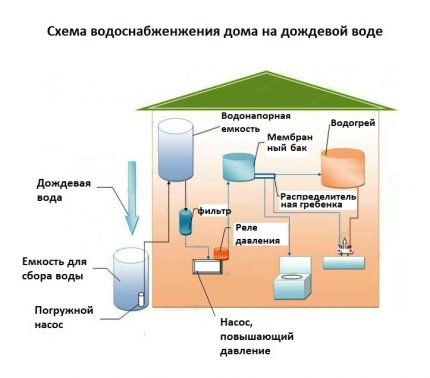
Thanks to the use of rainwater, the depreciation of pumping and cleaning equipment, there is a saving in personal budget.
The system is so simple that in the absence of a fully finished factory model, you can always assemble it yourself.
The main purpose of the catchment system is to collect the maximum amount of rainwater and move it to the storage tank. Further, the liquid is used for various household needs: washing, washing, cleaning, watering.
For watering, additional cleaning is not necessary, but for showering or washing dishes, the water must be filtered. To this end, several filters are cut into the water distribution, and both rough and fine cleaning will be required.
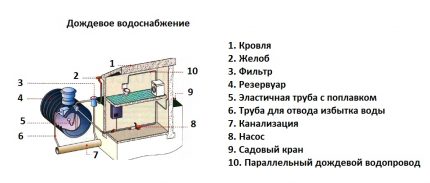
The reserve water tank can help out if there is a shortage of water from the main source, and when force majeure occurs.
If you decide to clean the well, then volumetric tank will allow you to wash, and wash, and water the summer cottages. Instead of one capacity, you can install several, then you do not have to save.
Organization of collecting rainwater for the home
Installation of equipment for collecting rainwater does not require permits or compliance with any strict standards. At its core, this is a variant of the usual drainage system, but more rational.
In order for the accumulation and transportation of water to be more effective, it is necessary to take into account some nuances - the condition of the roof, types of storage tanks, and the possibility of quickly pumping water into the house.
Step # 1 - choosing the optimal roof shape
There is a popular opinion that only sloping roofs are suitable as a working surface for collecting water. Indeed, when water flows by gravity into the gutters located around the perimeter, it is easier to organize its movement in the right direction. To do this, you do not need to install additional "traps" and lay communications under the roof.
In fact, there are systems designed for flat roofs. When laying layers of insulation and waterproofing, a slope of at least 3% is observed, and a gutter or tray for collecting water is installed at the lowest point.
Among the drainage devices of flat roofs, there are funnels attached to the gutters. The risers can be located both inside the building and installed on the outer wall.
To stimulate the movement of water to the water intake funnel, a decrease in radius of half a meter is arranged around it.

The design of the funnel may be different. For example, for inversion roofs, two-level roofs are provided that collect and discharge condensate from under the insulation layer and rainwater from the roof surface.
Traditional flat roofs are equipped drainage devices with one level, thanks to which rainwater is redirected to the gutter system.
All types of water intake devices should be equipped with mesh protection against volatile pollution, foliage and dust. For trays, gutters and funnels, protective devices are produced in the form of perforated panels, mesh baskets, etc.
On operated flat roofs, a flat protection is installed flush with the surface, on non-operated roofs it rises above the roof. In addition to the main funnel, several backup ones are installed, in case the main one becomes clogged and fails.
All devices lead to one pipeline. It has an internal location, that is, it is located under the roof, and a sealed, closed shape, most often a rectangular box. The gravitational channel is wider, narrow siphon-vacuum. The outlet is located above or near the storage tank.
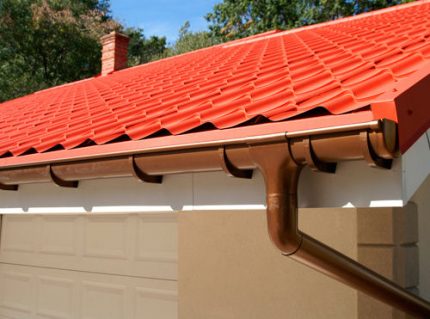
The shape of the roof also does not affect the composition of the water, and roofing material can cause poisoning or disease. As you know, asbestos, which is just part of asbestos slabs and slate, is very dangerous.
Now these materials are rarely used for roofing, but if you decide to provide an old house with a drainage system, be on the lookout. Copper and lead are also dangerous, they can be contained in pipes, gutters or fasteners.
Safe roofing options:
Absolutely safe and modern. PVC gutter systemsmost convenient for DIY installation.
Step # 2 - selection of water collectors and reservoirs
Precipitation falls irregularly; therefore, there are no devices without a “transshipment base” that directly connect the trays to the taps. It is necessary to organize a large container for storing collected water, which will allow to use it only as needed.
An ordinary barrel was the prototype of all modern tanks. It can now be found in summer cottages, installed directly under the drainpipe.
The effectiveness of using the barrel is conditional, since it has a small volume and is not suitable for water supply at home. In addition, overflow systems are not planned in its design, all surplus spills over the edges and enters the ground.
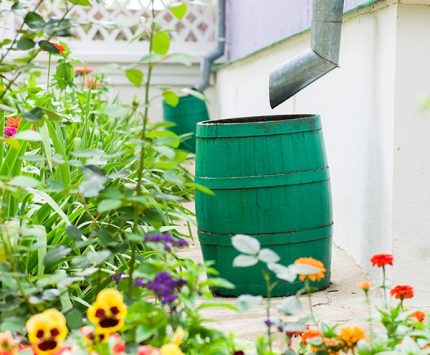
Volumetric tanks are made for water storage systems, which can be divided into two categories:
- groundinstalled under the gutter system against the wall (or inside the building);
- undergroundburied in the ground near the house.
The material for all types is the same - it is polyethylene, more rarely concrete, fiberglass or steel. Synthetic rainwater drives are leading, because they are not inferior in characteristics to analogues from other materials, at the same time they are much lighter, and therefore more convenient for transportation and installation.
The volume of ground tanks - from 750 to 2000 liters, underground - from 2000 to 5000 liters.
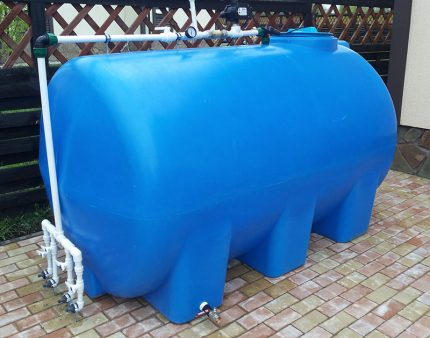
Large underground tanks are equipped with surface or submersible pump for forced movement of water to the points of drawing. The use of various equipment requires additional liquid purification. For this, a filtration system is used: a coarse filter is installed at the inlet to the tank, and the same at the outlet.
Options for plastic tanks for collecting and storing rainwater:
If water enters the sinks for washing or washing dishes, fine filters with a mesh of no more than 5 microns, as well as multi-stage coal plants, are required.
Step # 3 - organization of the drainage system
Suppose your private home is equipped with a full rainfall, including a set of gutters and trays, downspouts, sand traps and a sewer outlet small septic tank.
Is it possible to install a structure for using rainwater in a house without major changes? Of course, but it will be necessary to supplement the scheme with storage capacity and related equipment.
First you have to analyze the state of the accumulating plane, that is, the roof. You should check its integrity, cleanliness, and if necessary, change the roofing to a safer one.
If the storm construction of pipes and trays is in order, you can attach a large prefabricated polyethylene tank directly to it. At the bottom of the tank, install a fitting - for emergency drain.
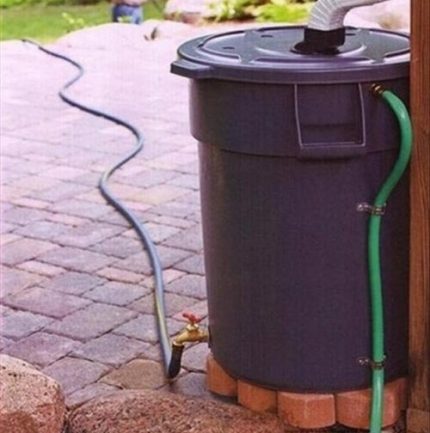
If there is a need to install a large underground tank, you will have to make adjustments to the old structure - most likely, change the location of the sewer pipes. Digging out the pit and installing pumping equipment, it is necessary to re-lay communications for drains.
We offer two options for the installation of rainwater use systems - with a ground and underground tank.
Simple barrel device
To assemble the lightest circuit, you need a kit for installing gutters, a filter, a finished water tank, a short hose and mounting hardware.

We purchase plastic gutters, trays and pipes of the required size in a hardware store. If you are not satisfied with plastic, we use galvanized steel parts, home-made or factory-made.
We collect the drainage system in the following order:
- using special brackets or hooks we fix along the edge of the roof of the gutter;
- at the corner, in a place convenient for installation of the tank, we hang a drainpipe;
- we connect the main elements with a receiving funnel;
- we seal seams and joints.
At installation of gutters make sure that there is a slight slope towards the pipe (2-3 cm per 1 m). The dimensions of pipes and gutters depend on the area of the roof. For example, a diameter of 80 mm is enough for equipping a ramp of 25-30 m².
When collecting the corner pipe to which the tank will be connected, do not forget to insert the filter. A funnel can be equipped with the same filter to delay debris and sand.
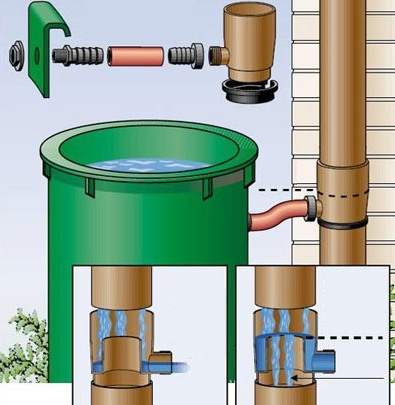
We mark with a marker, determining the height of the drainage system at the level of the upper part of the tank.

We take out the sawn section and insert the collector in its place.
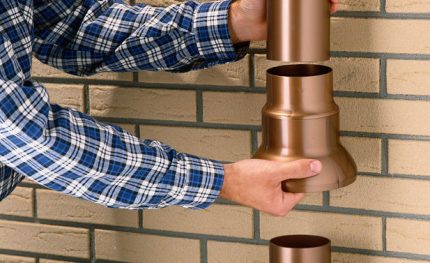
Tightly twist the water intake, then attach a hose to it. This is easy to do if you install a fitting in advance.Under the tank cover, cut a hole of a suitable diameter, insert the second end of the hose into it.
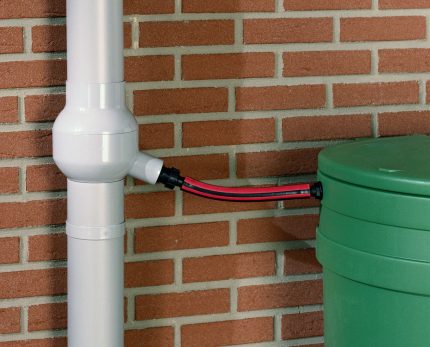
An important nuance: a well-prepared base will help excess water to freely go into the ground (or sewer well), and not spill along the house or flood the foundation.
The site for installing the tank is covered with gravel, on top make a stand of ceramic blocks or bricks.
Another installation instructions for the Aquacan catchment:
The assembly of factory models is good in that all the necessary parts and even part of the tools are included with the container.
The scheme of the device with an underground tank
A large tank installed near the house will be able to satisfy the need for water by 50%. Thanks to the special wiring, rainwater will flow to the draw-off points that do not require high-quality liquids: to toilet tanks, kitchen and watering taps. But in this case, filters are installed.
The tank can be installed under gutter system on the surface, in the basement or in the foundation pit, dug near the house. We will choose the third option, in which the tank will be completely immersed in the ground, therefore, it will not occupy an empty area near the building and not spoil the beautiful landscape with its technological appearance.
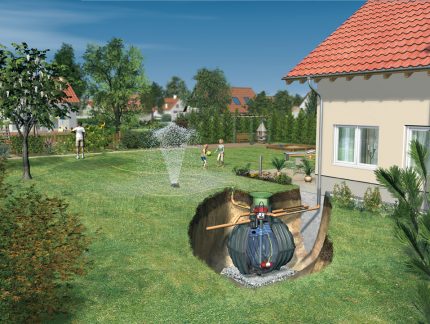
We select a container with a volume of 2.5-3.5 thousand liters, and, based on its dimensions, we are looking for a place for installation. In addition to the dimensions when digging a pit, we necessarily take into account the horizons of groundwater and the level of freezing.
The depth of the pit should be approximately 70 cm greater than the height of the tank, since 20 cm is a gravel-sand cushion, 50 cm is a layer of earth above the reservoir (freezing in the middle lane and northern regions in winter).
Next, we follow the scheme:
- we get the soil, we take the excess to the side;
- arrange a gravel-sand rammed pillow;
- install a tank in the center of the pit;
- we fill it with a mixture of soil and sand on all sides;
- install pumping equipment and pipes (downpipes and leading to the house).
Of course, before connecting electrical equipment, it is necessary to establish a water supply system from the roof and make internal wiring. Gutters are installed in the traditional way, the pipe through the hatch delivers water to the tank.
Piping from the reservoir leads to certain pre-selected points. Inside the house, in the back room or in the basement, there is a place for installing a pump, filters, monitoring equipment.
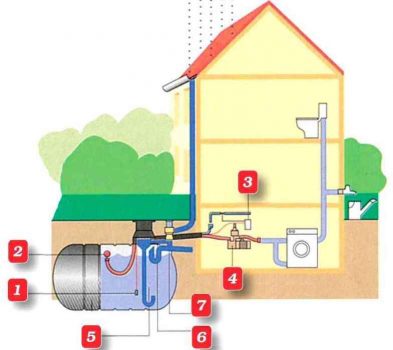
After installation and connection, it is necessary to carry out a test start: pour into the water tank and turn on the pump. If everything is in order, the liquid will quickly flow to the points of tapping.
The container should not be empty, as soil movements can cause deformation of the body. If water runs out during a drought, it must be filled from the main source. In order not to measure the water level using improvised means, you can draw a kind of scale with divisions in shares or liters on the inside of the wall.
Rainwater in the heating system
In some cases, rainwater is used instead of distilled liquid or antifreeze in heating systems of private houses.
Natural characteristics - softness, lack of impurities and cleanliness - make it suitable for pouring into the heating network. To remove possible contaminants "caught" in the atmosphere, it is initially driven through a filter.
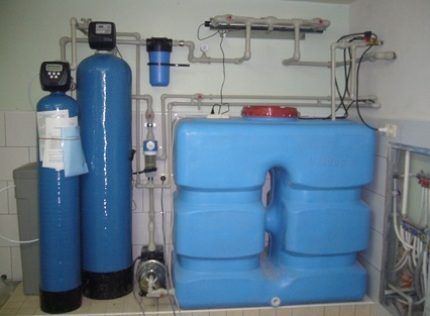
In addition to cleaning procedures, enrichment of the liquid with special inhibitors and surfactants helps reduce the tendency of water to form corrosion and plaque. Chemical compounds contribute to the dissolution of calcareous and other deposits.
Conclusions and useful video on the topic
Educational informational videos will help you independently install a storage tank for collecting rainwater.
Video # 1. How to make a do-it-yourself rainwater collection system with an external tank:
Video # 2. Useful theoretical information:
Video # 3. Preparation of a plastic barrel for autonomous water supply:
The purity and natural softness of rainwater make it possible to use it for domestic household needs, irrigation, and sometimes - to fill the heating system. Thanks to the large storage tank and pump, you can always use the backup water source that is relevant during the emptying of the well.
If you have interesting information, valuable recommendations, or your own experience in designing a system built to collect rainwater, please leave comments. To place them below the text of the article, a block form is open.

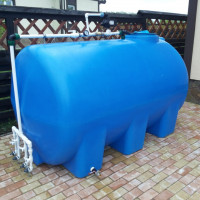 Plastic containers for water: types, advantages and disadvantages + recommendations for selection
Plastic containers for water: types, advantages and disadvantages + recommendations for selection 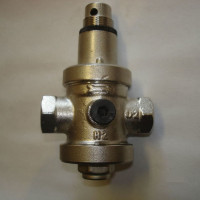 Water pressure reducer in the water supply system: purpose, device, regulation rules
Water pressure reducer in the water supply system: purpose, device, regulation rules 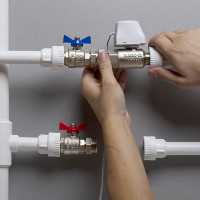 Water leakage sensor: how to choose and install a do-it-yourself anti-flood system
Water leakage sensor: how to choose and install a do-it-yourself anti-flood system  Overview of protection against water leaks “Aquastorozh”: device, advantages and disadvantages, installation rules
Overview of protection against water leaks “Aquastorozh”: device, advantages and disadvantages, installation rules 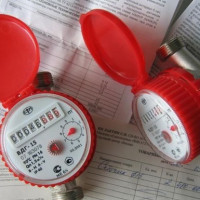 Water supply and sanitation rules: balance calculation + norms of water supply and consumption
Water supply and sanitation rules: balance calculation + norms of water supply and consumption 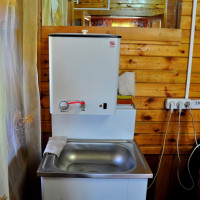 Cottage washbasin with heated water: ranking of the best models + tips for potential buyers
Cottage washbasin with heated water: ranking of the best models + tips for potential buyers  How much does it cost to connect gas to a private house: the price of organizing gas supply
How much does it cost to connect gas to a private house: the price of organizing gas supply  The best washing machines with dryer: model rating and customer tips
The best washing machines with dryer: model rating and customer tips  What is the color temperature of light and the nuances of choosing the temperature of the lamps to suit your needs
What is the color temperature of light and the nuances of choosing the temperature of the lamps to suit your needs  Replacement of a geyser in an apartment: replacement paperwork + basic norms and requirements
Replacement of a geyser in an apartment: replacement paperwork + basic norms and requirements
I have been using rainwater harvesting for a long time. The system is simple - an iron tank of 1000 liters and drains. Water goes to water the garden. To use this water elsewhere, it must be cleaned. So, it will require pumps, electricity and replaceable filters. Water will cease to be free, and this is its biggest plus. In addition, with rare use, it has the ability to deteriorate and turn green, which requires additional effort and investment in cleaning.
I immediately liked the idea of watering with rainwater.Moreover, in our country house there are interruptions in the supply of water. I bought several tanks that are behind the house (a total of 500 liters). A hose leads from them to the garden (connected from below to go by gravity). When there is no water in the water supply, I switch the supply to the house and use the water for sewage. I plan to add tanks - profitably.
Near a large city (namely, most of the summer cottages are located here), the quality of rainwater is very doubtful. The entire exhaust of cars, emissions of enterprises and thermal power plants - all this is absorbed by raindrops. For me - the well is more reliable.